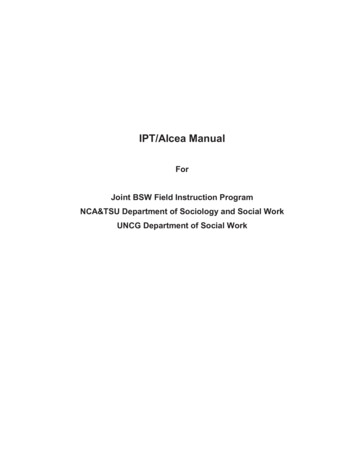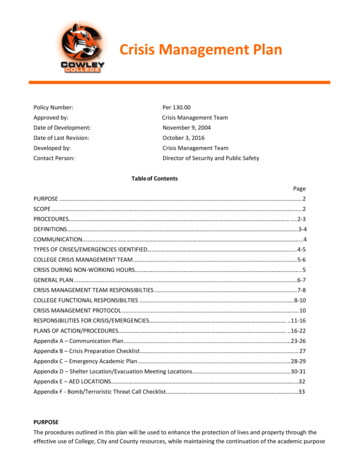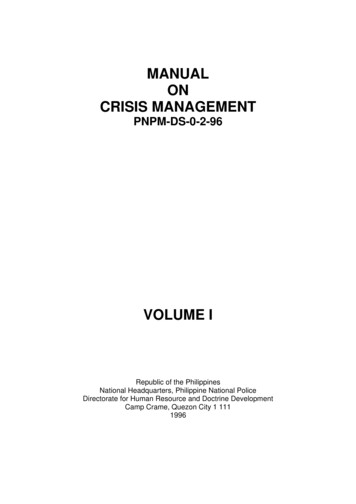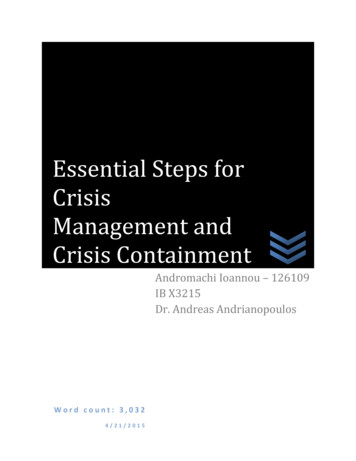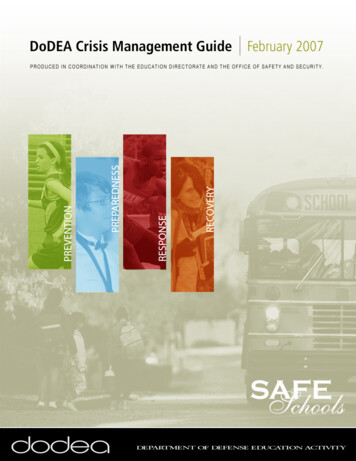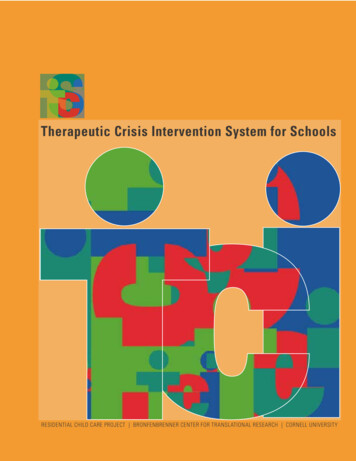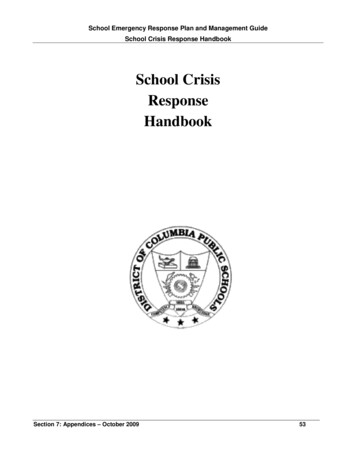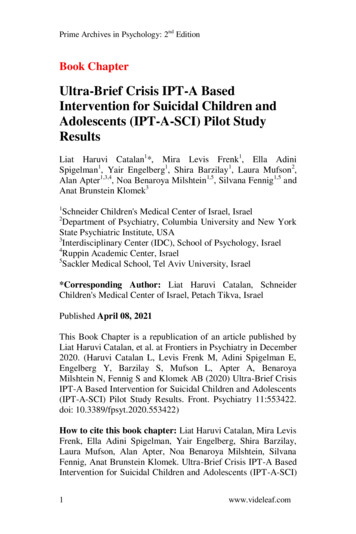
Transcription
Prime Archives in Psychology: 2nd EditionBook ChapterUltra-Brief Crisis IPT-A BasedIntervention for Suicidal Children andAdolescents (IPT-A-SCI) Pilot StudyResultsLiat Haruvi Catalan1*, Mira Levis Frenk1, Ella AdiniSpigelman1, Yair Engelberg1, Shira Barzilay1, Laura Mufson2,Alan Apter1,3,4, Noa Benaroya Milshtein1,5, Silvana Fennig1,5 andAnat Brunstein Klomek31Schneider Children's Medical Center of Israel, IsraelDepartment of Psychiatry, Columbia University and New YorkState Psychiatric Institute, USA3Interdisciplinary Center (IDC), School of Psychology, Israel4Ruppin Academic Center, Israel5Sackler Medical School, Tel Aviv University, Israel2*Corresponding Author: Liat Haruvi Catalan, SchneiderChildren's Medical Center of Israel, Petach Tikva, IsraelPublished April 08, 2021This Book Chapter is a republication of an article published byLiat Haruvi Catalan, et al. at Frontiers in Psychiatry in December2020. (Haruvi Catalan L, Levis Frenk M, Adini Spigelman E,Engelberg Y, Barzilay S, Mufson L, Apter A, BenaroyaMilshtein N, Fennig S and Klomek AB (2020) Ultra-Brief CrisisIPT-A Based Intervention for Suicidal Children and Adolescents(IPT-A-SCI) Pilot Study Results. Front. Psychiatry 11:553422.doi: 10.3389/fpsyt.2020.553422)How to cite this book chapter: Liat Haruvi Catalan, Mira LevisFrenk, Ella Adini Spigelman, Yair Engelberg, Shira Barzilay,Laura Mufson, Alan Apter, Noa Benaroya Milshtein, SilvanaFennig, Anat Brunstein Klomek. Ultra-Brief Crisis IPT-A BasedIntervention for Suicidal Children and Adolescents (IPT-A-SCI)1www.videleaf.com
Prime Archives in Psychology: 2nd EditionPilot Study Results. In: Paul Raj, editor. Prime Archives inPsychology: 2nd Edition. Hyderabad, India: Vide Leaf. 2021. The Author(s) 2021. This article is distributed under the termsof the Creative Commons Attribution 4.0 censes/by/4.0/),whichpermits unrestricted use, distribution, and reproduction in anymedium, provided the original work is properly cited.AbstractIn recent years, suicidal behaviors have shown substantialincrease worldwide. This trend is also prominent in Israel andhas led to a dramatic increase in mental health treatment demandresulting in long wait times and low treatment acceptance rate.To address the critical need in crisis intervention for children andadolescents at suicidal risk we developed an ultra-brief acutecrisis intervention, based on Interpersonal Psychotherapy (IPT).IPT is an evidence-based intervention for variouspsychopathologies among different age groups. The currentadaptation of IPT-A is comprised of five weekly sessions,followed by monthly follow-up caring email contacts to thepatients and their parents, over a period of three months. Thispaper aims to review the theoretical foundation of thisintervention, describe the research design, and presentpreliminary results of a pilot study. Results indicate meaningfultrends for both the suicidal ideation (SIQ) and depression (MFQ)outcome measures. The treatment appears to be safe, feasibleand acceptable and initial results show promising trends tosupport further study of the approach.KeywordsSuicide Attempts; Crisis; Intervention; Adolescents; Children(Min.5-Max. 8)IntroductionSuicidal ideation and behavior are major public health concerns.Data in recent years indicates an alarming increase in the2www.videleaf.com
Prime Archives in Psychology: 2nd Editionprevalence of suicide attempts, particularly among adolescents[1]. Although only a small proportion of suicide attempts arefatal, every attempt is fraught with a potential death and longterm physical and psychological effects [2]. Suicidal ideationand non-suicidal self-injurious (NSSI) behaviors have beenidentified as precursors for suicide attempts as well as potent riskfactors for eventual death. Despite the unequivocal need forimmediate and focused interventions for teens presenting withsuicidal ideation, NSSI, and suicidal behavior, to our knowledge,there are few evidence-based, suicide specific, interventions forthese at-risk youth. DBT-A for example has good evidence-baseand dissemination [3-5]. Other evidenced based psychotherapiesinclude CBT [6] MBT [7] and ABFT [8].In recent years these non-fatal suicidal behaviors have shownsubstantial increase despite trends in the Western world for areduction in actual suicide rates. This is apart from the US whereadolescent suicide rates have climbed probably due to theepidemic in opioid abuse [9]. This increase in non-fatal suicidebehavior has been seen in Israel as well [10].The rate of presentations to the pediatric emergency room (ER)at Schneider Children‟s Medical Center (SCMC) for suicidalbehavior (i.e. sever ideation, suicide attempts, NSSI) increased inrecent years and now stands at about 400 cases per year. Thisincrease in pediatric admissions to the ER has led to an overloadon outpatient services for our adolescent depression and suicidalbehavior clinic.These circumstances, have led to a long average wait time (atleast one year) and, low treatment acceptance rate (less than10%), which is clinically unreasonable when it comes to childrenand youth suffering from severe depression and suicidal risk. Inorder to meet these needs and deal with this public health crisis,we have developed an ultra-brief acute crisis interventionconsisting of five sessions which we are currently evaluating inan ongoing study. This paper aims to present the theoretical basisof this ultra-brief intervention, describe the research design, andpresent some preliminary results from a pilot study.3www.videleaf.com
Prime Archives in Psychology: 2nd EditionThe intervention developed is based on InterpersonalPsychotherapy (IPT) and on a comparable short-termintervention for suicidal adults [11].The selection of IPT is based on the many studies linkingbetween interpersonal problems and suicide risk [12]. Those atrisk for suicide suffer from significant interpersonal challenges[13]. Insecure attachment has specifically been found to be a riskfactor for suicide in adolescents [14]. Moreover, problems withsharing feelings with others have been found to be an importantrisk factor for severe suicide attempts, above and beyond thecontribution of depression and hopelessness [15,16].IPT is a commonly used and evidence-based treatment fordepression among adults [17,18] and adolescents (IPT-A,Mufson, [19]) as well as for several other disorders such asanxiety [20] and eating disorders [21]. It has been shown to beeffective in reducing symptoms of depression and in improvingoverall performance and social functioning of patients [22,23].IPT-A, is an adaptation of the IPT protocol specifically tailoredfor depressed adolescents [19]. It is a time-limited evidencebased psychotherapy that addresses the link between depressedmood and current interpersonal problems. The goal of IPT-A isto reduce depressive symptoms and improve interpersonalfunctioning by identifying an interpersonal problem area of focusand by developing communication and problem-solvingstrategies for dealing with the interpersonal problems [19].Mufson et al [24] presented preliminary outcomes of a smallsample of IPT-A for depressed youth engaging in suicidalbehavior (IPT-A-SP). The results indicated that IPT-A is afeasible treatment for adolescents at risk for suicide. Graham etal [25] are in the process of publishing their work on anadaptation of the IPT protocol for suicidal adults as a part oftheir crisis intervention treatment (IPT-AC). To our knowledge,no other IPT-based adaptation suitable for suicidal youth isavailable or has been empirically examined.4www.videleaf.com
Prime Archives in Psychology: 2nd EditionShort Term Intervention in Suicidal AdultsStudies carried out among adults have shown that brief andfocused therapy can be effective for patients at high risk ofsuicide. For example, Gysin-Maillart et al. [11] compared twogroups of adults presenting to the ER following a suicideattempt. Both groups received treatment as usual (TAU), whichincluded inpatient, day patient, and individual outpatient care asconsidered necessary by the clinicians in charge of patientmanagement. The research group received, in addition to TAU,three 60-90-minute therapy sessions that were focused on thesuicide attempt. This group of patients also received personalletters from the clinic every 3-6 months for a period of 24months. The results showed a significant decrease in suicideattempts within the research condition in comparison to thecontrol group.Another study followed 843 adults who were hospitalized due todepression or suicidal risk in a psychiatric ward in San Franciscoand refused further treatment upon their release. The study wasconducted over the course of five years, comparing two groupsof participants; The experimental group, which received personalpostcards 4 times per year for the duration of the study, and thecontrol group which received no further contact. A follow-upprocedure identified patients who died during the five-yearcontact period. Suicide rates in the contact (experimental) andno-contact groups were compared. The five-year-follow-uprevealed lower suicide rates within the contact group comparedto the control group [26].Based on these two lines of studies (IPT-A and short-terminterventions for suicidal adults) we set out to develop andexamine a brief and focused IPT-A based acute crisisintervention, adapted for suicidal children and adolescents. Tothe best of our knowledge, despite the tremendous service gapand devastating consequences of the global suicide epidemicamong children and adolescents, there is no study whichexamines a very short, practical and feasible crisis interventionfor children and adolescents at risk of suicide.5www.videleaf.com
Prime Archives in Psychology: 2nd EditionThe InterventionThe intervention has 2 main goals: (1) Immediate interventionfor depression and suicide ideation. We offer a very short andfocused treatment, allowing for immediate response in cases ofsuicidal risk. By being ultra-short, the protocol may be offered tomore youth within a significantly shorter wait time; (2) Buildinga roadmap for future treatment after the suicidal risk isreduced. During the intervention, we build a roadmap forcontinued patient care in the community. We try to identify themain difficulties leading to the patient's suicidal behavior, and toassist the patient and family in understanding how these needscan be met.The intervention is comprised of five weekly sessions followedby monthly emails to the patients and their parents over a periodof three months. The first session is aimed at introducing theintervention, assessing depression and suicidal risk and buildinga safety plan [27]. The safety plan consists of a prioritized list ofcoping strategies that the patient can use when suicidal risk isincreased. The second session is focused on reviewing thepatient‟s interpersonal relationships (using the closeness circleand interpersonal inventory) and conceptualizing theinterpersonal problem area (the focus for the intervention).Sessions 3-4 focus on developing and practicing interpersonal,emotional and behavioral coping strategies relevant for suicidalrisk. Lastly, in session 5, patient and therapist go over theprocess and main issues which were worked on, emphasizingrelapse prevention by going back to the safety plan. First andfifth sessions always involve the parents. In other sessions,parents are invited as needed. After completion of theintervention, four personal emails addressed to the patients andparents are sent by the clinic. These are sent two, four, eight, andtwelve weeks following the last session. The email messages arebased on a template that includes care contacts, elements of thesafety plan and skills acquired during the intervention,suggestions to parents and patients and emergency contactinformation.6www.videleaf.com
Prime Archives in Psychology: 2nd EditionResearch DesignThe goal of the study is to examine the feasibility andeffectiveness of an ultra-brief IPT-A based acute crisisintervention, as first aid for suicidal children and adolescents, inan outpatient setting. The study was approved by IRB committeeat Schneider Children‟s Medical Center (SCMC).MethodParticipants: All study participants are patients at the SCMCdepression and suicidal behavior clinic, referred due todepressive symptoms and/or suicidal ideation/behavior. Patientsreceive routine care and those who give informed assent andguardian consent are assessed routinely via a battery of self andparent report questionnaires.Since the beginning of the study about 80 children andadolescents, aged 6 – 18, have consented to fill study baselineand follow up assessments. Exclusion criteria include acutemedical condition, mental retardation, cognitive impairment, orlinguistic limitation. We present here preliminary data of the first26 children/adolescents recruited who have completed 2-3measurement timepoints (Initial evaluation, Pre-treatment, Posttreatment).Procedure: Patients are referred to SCMC depression andsuicide clinic through the ER, outpatient providers or are selfreferred. They undergo an initial evaluation and risk assessment.Following initial evaluation, each subject is assigned to one ofthree study groups, based on clinical considerations. In thisstratified randomization system, the most serious acute cases aregenerally referred to our ultra-short crisis intervention (IPT- ASCI) and the rest are randomized to either one of the threegroups: IPT- A SCI, Treatment as usual (TAU) and waiting list(WL). All participants and their parents complete thequestionnaires via a secure electronic interface, with the aid of atrained research assistant. Treatment drop-out rates, thus far,seem low and stand at about 11% for the IPT-A SCI and at about16% for patients who receive TAU.7www.videleaf.com
Prime Archives in Psychology: 2nd EditionThe IPT-A SCI follows the intervention protocol brieflypresented above, which includes an intensive phase of 5 weekly50-minute sessions and 3 follow up personal emails.Questionnaires are completed at baseline (initial evaluation),prior to the first session; at the end of the intensive phase; andthree, six, nine and twelve months following the end of the acuteintervention. TAU patients receive an integrative combination ofpsychodynamic, supportive and cognitive behavioral therapy,usually lasting between 10-30 weeks. TAU participants areassessed at the same time points with an added measurement atthe end of treatment. WL patients are monitored by a trainedclinician during their waiting period and complete the studyquestionnaire battery at the parallel time intervals. Table 1summarizes the measurement timeline for each study group.Table 1:Time01234567IPT-A-SCIInitial evaluationPre-treatmentPost-treatment3-months follow up(from the end of theintervention)6 months follow up9 months follow up12 months follow upTAUInitial evaluationPre-treatment5-week assessmentPost treatment3-months follow up(from the end of theintervention)6 months follow up9 months follow up12 months follow upWLInitial evaluation5-week assessment3-months follow up(from the end of lastevaluation)6 months follow up9 months follow up12 months follow upInstruments: The study included a battery of validated self- andparent-report questionnaires assessing suicidal ideation [SuicideIdeation Questionnaire (SIQ) [28] and behavior [Columbia–Suicide Severity Rating Scale (C-SSRS) [29], interpersonalfunctioning [Social Adjustment Scale- Self Report (SAS-SR)[30], depressive symptoms Mood and Feeling Questionnaire(MFQ) [31 , anxiety [The Screen for Child Anxiety RelatedEmotional Disorder( (SCARED) [32], attachment patterns Experiences In Close Relationships – Revised child versionQuestionnaire (ECR-RC) [33] and self-esteem [Rosenberg Selfesteem Scale (RSE) [34]. In this report we will only discuss theSIQ and MFQ, which are the two primary outcome measuresinitially identified for the study.8www.videleaf.com
Prime Archives in Psychology: 2nd EditionResultsIn order to estimate the feasibility of this intervention, analyseswere conducted on the first 26 children/adolescents whocompleted between 2 and 3 assessment timepoints. The sampleincluded 10 males and 16 females, between the ages of 9-17(Mean 13.44, SD 2.45). A repeated measures design was usedto compare three groups of patients who completed the SIQ andMFQ at initial evaluation (T0), pre-intervention (T1) and at 5week assessment (T2). 10 WL patients completed the initialevaluation and the 5-week follow up assessments, 10 IPT A SCIpatients completed initial evaluation, pre-intervention and postintervention assessments and 6 TAU patients completed initialevaluation, pre-intervention and 5-week follow up assessments.Results are meaningful for both the SIQ and MFQ outcomemeasures. Specifically, a significant interaction was evident forsuicidal ideation (F(4,46) 3.34, p .05); it appears that while WLpatients exhibited a slight increase in their suicidal ideationlevels between T0 (Mean 57.7, SD 14.98) and T2 (Mean 68.2,SD 14.24) (t(9) -2.75, p .05), suicidal ideation decreased in theIPT-A SCI (T0: Mean 57.4, SD 24.7; T1: Mean 29.4,SD 24.8; T2: Mean 17.6, SD 18.3 ) and TAU (T0:Mean 62.5, SD 27.8; T1: Mean 37.6, SD 35.8; T2:Mean 21.5, SD 34.54) patients, between both time intervals.Paired comparisons within treatment condition using Bonferroniadjustment revealed significant differences between T0 and T2measurements for the IPT-A SCI group (p .05) but not for TAU.Means and standard deviations are presented in Table 2.For depressive symptoms however, no interaction effect wasevident and all three patient groups exhibited a reduction acrosstimepoints [WL (T0: Mean 76.0, SD 24.99; T2: Mean 15.5,SD 13.2) TAU (T0: Mean 89.5, SD 29.43 T1: Mean 28.33,SD 20.44; T2: Mean 19.33, SD 21.67) IPT A SCI (T0:Mean 83.5, SD 31.3; T1: Mean 20.3, SD 17.7; T2:Mean 15.7, SD 15.08)]. Paired comparisons using Bonferroniadjustment revealed significant differences between T0 and T2for all patients (P .001), as well as significant reductionsbetween T0 and T1 for the TAU and IPT-A SCI groups9www.videleaf.com
Prime Archives in Psychology: 2nd Edition(P .001). Nevertheless, the slope seems to flatten between T1and T2, and these very preliminary results might suggest that thelevel of depression may not be specifically affected by theinitiation of any of the interventions. Figures 1 and 2 illustratethe above findings.Table 7)15.5(13.2)T0 T1**T0 T2**T0 T2**T0 T2*T0 T2*T0 T1**T0 T2***p .05**p .001Figure 1: Suicidal ideation by group and measurement.10www.videleaf.com
Prime Archives in Psychology: 2nd EditionFigure 2: Depressive symptomology by group and measurement.DiscussionIn this brief report, we have described a new adaptation of anacute ultra-brief crisis intervention for children and adolescentsat suicidal risk, developed in our depression and suicide clinic atSCMC, and reviewed its theoretical foundations. It seems thatthe intervention is feasible and safe. The intervention group wassuperior to wait list group in reducing suicide ideation. Theintervention, however, did not differ from the two comparisongroups in reducing symptoms of depression. The difference inoutcomes for the suicide ideation and depression needs furtherinvestigation. We could assume that this is due to the suicidespecific nature of the intervention protocol we present.The treatment appeared to be acceptable to subjects and parents,and, at least in this pilot stage, dropout rates were very low,which is encouraging, since treatment studies of suicidaladolescents are notorious for high numbers of dropout [35].IPT-A is a relevant intervention for at risk youth since it focuseson the interpersonal aspects which often precipitate acutesuicidal crises. All available interventions [CBT [6] DBT [3]include interpersonal aspects but these aspects are notnecessarily the focus of the treatment. ABFT focuses on11www.videleaf.com
Prime Archives in Psychology: 2nd Editioninterpersonal aspects in a family format [8]. Until recently, manystudies that have examined the efficacy of IPT-A have generallyexcluded participants with severe and active suicidal ideationand attempts despite the possibility that IPT-A may be beneficialfor this population.The intervention presented in the current study is the first tofocus on interpersonal aspects in an ultra-short individual format.It is not our supposition that this treatment is sufficient for theseadolescents, but it may be a cost-effective „first aid‟ intervention,which will help them through an acute csirir as well as generatehope regarding the prospect of therapy, thereby getting them toengage in longer term services.Using this ultra-brief intervention has important public healthimplications. Non-fatal adolescent suicidal behavior, in all of itsvarious forms, has become increasingly common in the lastdecades. These high-risk behaviors pose a major public healthproblem, imposing unbearable load on emergency rooms andpublic psychiatric services. Public mental health services inIsrael struggle to handle the load, cases may be left un-treated fordangerously long periods of time. Therefore, there is a real needa for brief forms of crises interventions. Intervention like IPT-ASCI may be able to reduce the load on child and adolescentmental health services and allow larger portions of at-riskpatients to be treated.Furthermore, provided our future large-scale study‟s resultscontinue the promising trends evident in our pilot analyses, thisprotocol can be a basis for other types of crises interventions invarious fields and populations. Likewise, our protocol couldpotentially be adapted to other populations at other age groups orsuffering from other psychopathologies. In addition, IPT-A-SCIcould serve as a platform for crises interventions based on othertherapeutic models such as CBT or DBT, whereby a 12-16session long protocol is condensed into a 5-session „first aid kit‟,maintaining the main therapeutic components and directing thepatient for future care.12www.videleaf.com
Prime Archives in Psychology: 2nd EditionDespite the many limitations of this preliminary report, thetreatment has proven safe, feasible and acceptable and initialresults show promising trends. We are in the process ofdeveloping a larger, randomized control study, which willinclude a larger sample and the other measures included.References1. Hedegaard H, Curtin SC, Warner M. Suicide rates in theUnited States continue to increase. US Department of Healthand Human Services, Centers for Disease Control andPrevention, National Center for Health Statistics. 2018.2. Itzhaky, Liat, Gratch, Ilana, Galfalvy, Hanga et al.Psychosocial risk factors and outcomes associated withsuicide attempts in childhood: A retrospective study. Journalof Psychiatric Research. 2020; 125.3. Miller AL, Rathus JH, Linehan, MM. Dialectical behaviortherapy with suicidal adolescents. New York: Guilford Press.2007.4. Mehlum L, Ramberg M, Tørmoen AJ, Haga E, Diep LM, etal. Dialectical behavior therapy compared with enhancedusual care for adolescents with repeated suicidal and selfharming behavior: outcomes over a one-year follow-up. JAm Acad Child Adoles Psychiatry. 2016; 55: 295–300.5. Mehlum L, Tørmoen AJ, Ramberg M, Haga E, Diep LM, etal. Dialectical behavior therapy for adolescents with repeatedsuicidal and self-harming behavior: a randomized trial. J AmAcad Child Adolesc Psychiatry. 2014; 53: 1082–1091.6. Stanley B, Brown G, Brent DA, Wells K, Poling K, et al.Cognitive-behavioral therapy for suicide prevention (CBTSP): treatment model, feasibility, and acceptability. Journalof the American Academy of Child and AdolescentPsychiatry. 2009; 48: 1005–1013.7. Rousseau D, Cook-Cottone C. Trauma-informed yogatraining in Kenya: A qualitative pilot study on feasibility andacceptability. Complementary Therapies in Medicine. 2018;40: 53-60.8. Diamond G, Russon J, Levy S. Attachment-Based FamilyTherapy: A Review of the Empirical Support. FamilyProcesses. 2016; 55.13www.videleaf.com
Prime Archives in Psychology: 2nd Edition9. Ashrafioun L, Bishop TM, Conner KR, Pigeon ER.Frequency of prescription opioid misuse and suicidalideation, planning, and attempts. Journal of PsychiatricResearch. 2017; 92: 1-7.10. Israely ministry of health. Suicide in Israel. 2018. AvailableOnlineat:www.health.gov.il/English/News and Events/./Pages/07082017 2.aspx11.12. Gysin-Maillart A, Schwab S, Soravia L, Megert M, MichelK. A Novel Brief Therapy for Patients Who Attempt suicide:A 24 months Follow Up Randomuzes Controlled Study ofthe Attempted Suicide Short Intervention Program (ASSIP).PLOS Medicine. 2016; 13.13. Jacobson CM, Mufson L. Interpersonal psychotherapy fordepressed adolescents adapted for self-injury (IPT-ASI):rationale, overview, and case summary. American journal ofpsychotherapy. 2012; 66: 349-74.14. Joiner T, Kalafat J, Draper J, Stokes H, Knudson M, et al.Establishing standards for the assessment of suicide riskamong callers to the national suicide prevention lifeline.Suicide Life Threat Behaviour. 2007; 37: 353-365.15. Falgares G, Marchetti D, De Santis S, Carrozzino D, KopalaSibley DC, et al. Attachment Styles and Suicide-RelatedBehaviors in Adolescence: The Mediating Role of SelfCriticism and Dependency. Frontiers in psychiatry. 2017; 8:36.16. Levi Y, Horesh N, Fischel T, Treves I, Or E, et al. Mentalpain and its communication in medically serious suicideattempts: an “impossible situation”. Journal of AffectiveDisorders. 2008; 111: 244-250.17. Horesh N, Levi Y, Apter A. Medically serious versus non –serious suicide attempts: relationshipso lethality and intent toclinical and interpersonal characteristics. Journal ofAffective Disorders. 2012; 136: 286-293.18. Klerman GL, WeissmanMM, RounsavilleBJ,Chevron E.Interpersonal psychotherapy for depression. New York:Basic Books. 1974.19. Markowitz JC, Weissman MM. Casebook of interpersonalpsychotherapy. Oxford: Oxford University Press. 2012.14www.videleaf.com
Prime Archives in Psychology: 2nd Edition20. Mufson L, Dorta KP, Moreau D. Interpersonalpsychotherapy for depressed adolescents. 2nd edition. NewYork: Guildford Press. 2004.21. Mahan RM, Swan SA, Macfie J. InterpersonalPsychotherapy and Mindfulness for Treatment of MajorDepression With Anxious Distress. Clinical Case Studies.2018; 17: 104–119.22. Waldron HL, Tanofsky‐Kraff M, Wilfley DE. InterpersonalPsychotherapy for Clients with Eating Disorders. In: LHChoate, editor. Eating Disorders and Obesity. 2015.23. Mufson L, Weissman MM, Moreau D, Garfinkel R. olescents. Arch Gen Psychiatry. 1999; 56: 573–579.24. Spence S, O‟Shea G, Donovan C. Improvements ychotherapy (IPT) with Adolescents and their Associationwith change in Depression. Behavioral and CognitivePsychotherapy. 2016; 44: 257 – 272.25. Mufson. Presented at IOWA IPT conference preliminaryOutcomes of IPT-A for Depressed Youth Engaging inSuicidal Behavior. 2015.26. Graham P, IrvineFitzpatrick L, Bowyer D, Steel, Taylor R, etal. Proof of concept: Interpersonal Psychotherapy AcuteCrisis (IPT AC) for deliberate self-poisoning/selfharm. 2020.27. Motto JA, Bostrom AG. A randomized controlled trial ofpostcrisis suicide prevention. Psychiatric services. 2001; 52:828-833.28. Stanley B, Brown GK. Safety planning intervention: A briefintervention to mitigate suicide risk. Cognitive andBehavioral Practice. 2012; 19: 256–264.29. Reynolds W. Suicide Ideation Questionnaire. Odessa:Psychological Assessment Resources. 1987.30. Posner K, Brown KG, Stanley B, Brent AD, Yershova VK, etal. The Columbia–Suicide Severity Rating Scale: InitialValidity and Internal Consistency Findings from ThreeMultisite Studies with Adolescents and Adults. Am JPsychiatry. 2011; 168: 1266–1277.31. Weissman MM, Orvaschel H, Padian N. Children‟s symptomand social functioning self-report scales: Comparison of15www.videleaf.com
Prime Archives in Psychology: 2nd Edition32.33.34.35.36.16mother's and children's reports. Journal of Nervous MentalDisorders. 1980; 168: 736-740.Angold A, Costello EJ, Messer SC, Pickles A. Developmentof a short questionnaire for use in epidemiological studies ofdepression in children and adolescents. International Journalof Methods in Psychiatric Research. 1995; 5: 237–249.Birmaher B, Khetarpal S, Brent D, Gully M, Balach L, et al.The Screen for Child Anxiety Related Emotional Disorders(SCARED): Scale construction and psychometriccharacteristics. Journal of the American Academy of Childand Adolescent Psychiatry. 1997; 36: 553-554.Francesca Lionetti, Stefanos Mastrotheodoros & BenedettaEmanuela Palladino. Experiences in Close RelationshipsRevised Child version (ECR-RC): Psychometric evidence insupport of a Security factor, European Journal ofDevelopmental Psychology. 2018; 15: 452-463.Rosenberg, M. Conceiving the Self. New York: Basic Books.1979.Burns CD, Cortell R, Wagner BM. Treatment compliance inadolescents after attempted suicide: a 2-year follow-upstudy. Journal of the American Academy of Child andAdolescent Psychiatry. 2008; 47: 948–957.www.videleaf.com
Book Chapter Ultra-Brief Crisis IPT-A Based Intervention for Suicidal Children and Adolescents (IPT-A-SCI) Pilot Study Results Liat Haruvi Catalan 1*, Mira Levis Frenk , Ella Adini Spigelman 1, Yair Engelberg1, Shira Barzilay , Laura Mufson2, Alan Apter1,3,4, Noa Benaroya M
